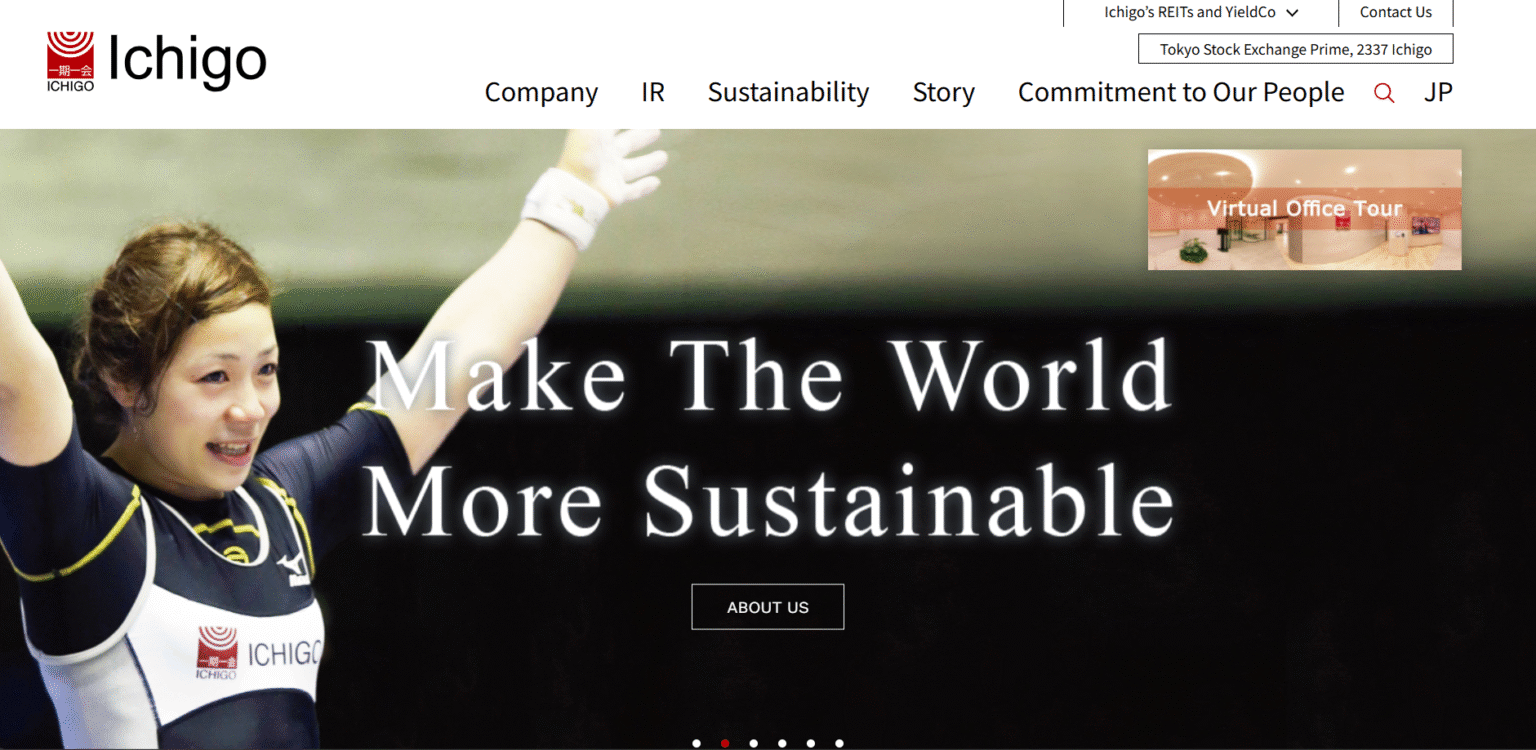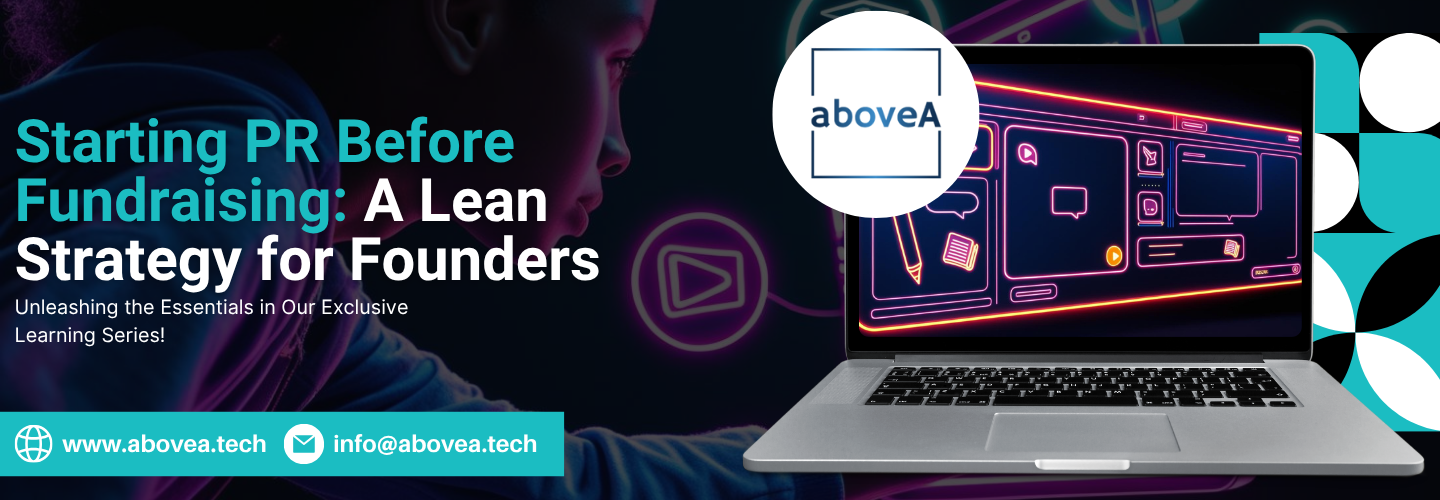

A content writer for aboveA. I’m passionate about blending creativity with data-driven insights to craft accessible, resonant content for diverse audiences.
Why Founders Should Start PR Before Fundraising (and How to Do It Lean)
Are you approaching the fundraising stage for your startup? Ensure you don’t forget one of the most critical factors for developing successful fundraising: a well-defined public relations strategy.
Lots of founders tend to overlook the importance of PR, but how else are you going to attract early funding? You need to start building your brand image as early as possible. Investors are looking for businesses that have potential for market interest, credibility, and upward momentum; PR helps to demonstrate that your business possesses all of these qualities.
It can sound daunting, but there are many ways to develop a realistic PR plan tailored to your specific needs and resources. You don’t need a huge budget or a large team to get started! Keep reading this article to find out more about why your startup needs an early PR strategy.
Want to learn more about developing a personal PR plan?
Table of Contents
Why PR Before Fundraising? (And Why Founders Overlook It)
PR can be done after fundraising, but it’s even more effective if you do it beforehand. The power of PR shouldn’t be overlooked! Here are a few common questions asked about why you should start PR before fundraising:
Should founders start PR before fundraising?
Yes! Your initial PR strategy is what investors use to get a first look at the potential of your startup. Building a compelling narrative behind your startup, demonstrating your credibility, and showing proof of your upwards traction can all be done with good PR. Having good PR will only encourage potential investors to put their trust in you and your pitch.
Should I only do PR after I raise?
This is a common myth. Only starting to do PR after you’ve raised money is a risky move, even when you might have more resources to enhance your approach. By starting PR early, you can mitigate potential concerns that may lead to negative perceptions and also be proactive about how you want investors to view your company.
Does a PR story matter in investor decisions?
Yes! A well-crafted PR narrative can help drive investor interest, even in early funding stages. Having a positive image across media platforms will support your business’s good reputation and demonstrate why you are worth investing in. The unique story behind your startup will make you stand out and showcase your specific value to the existing market.
Do investors actually “Google you” before replying to your pitch?
Yes, you can assume that some, if not most, investors will conduct their own research on your business before responding to your pitch. That’s why an early PR strategy matters so much! This is all part of them doing their due diligence to ensure that your startup is not only credible but also demonstrates potential for growth with their financial assistance.
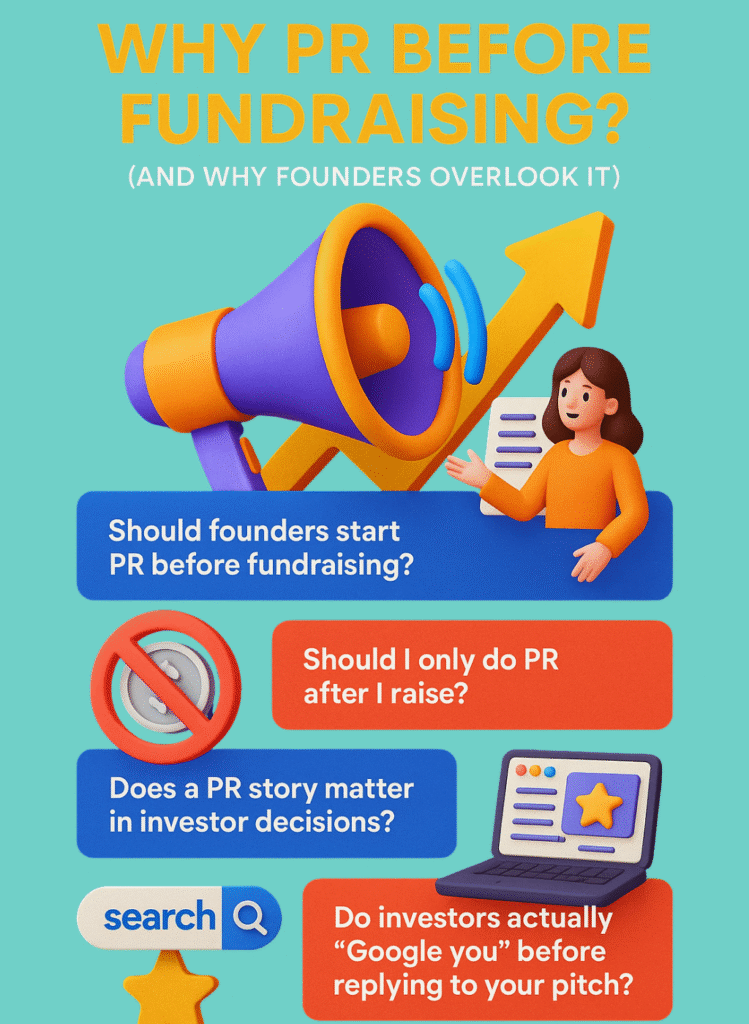
How Good PR Can Help You Raise More, Faster
Effective PR will help you raise more funding for your startup at a faster pace. Once you have a credible online platform and word gets out in the market, it’ll be much easier to establish trust with potential investors. The following are some of the key benefits of PR for startups in early funding stages:
Build your brand authority before you pitch
Having a concrete brand identity before you pitch will create a firm foundation for your authority over your startup. If you can consistently and effectively market your brand identity, your confidence in it will be evident in your future pitches.
Get warm investor introductions through media visibility
Having media visibility will make it easier for investors to be already familiar with who you are. These warm introductions can be fostered through potential investors who may have already heard of you from other people. Cold pitching can occasionally work, but having a good rapport in the media will bolster your reputation amongst investors in your network.
Increase inbound interest and perceived valuation
Your startup will seem more valuable when there’s more conversation about it in the media. If your product or service is creating a buzz in your target market, it’ll appear more valuable due to its necessity to consumers who are willing to buy. Use PR-related KPIs to track the effectiveness of your PR campaigns, and then make data-driven decisions to sustain inbound interest in your brand.
Help explain the ‘Why now?’ of your startup through trend coverage
The growth of good PR can easily prove an upward trend in coverage.Investors will appreciate a sense of urgency and understand why your startup should have a solid foothold in the existing market. Staying relevant, unique, and fresh is the goal!
Utilizing good PR is the easiest way to secure larger amounts of funding with less effort.
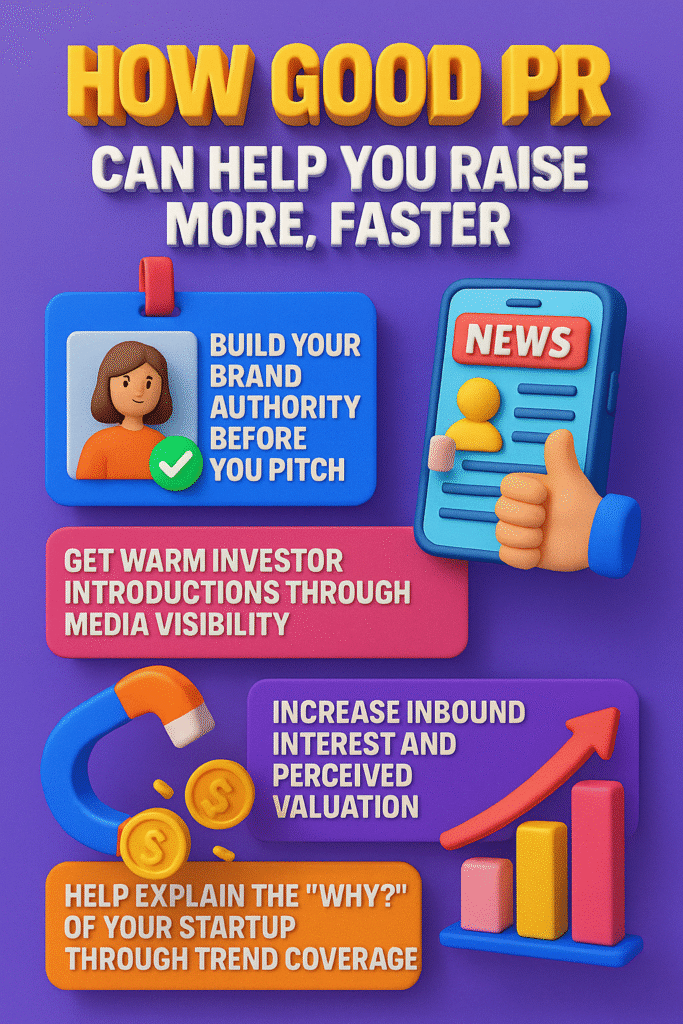
Real Examples: PR Strategy That Helped a Startup Raise Capital
Having a great PR strategy can make all the difference! Here are a couple of real-life examples of startups that effective PR strategies have boosted.
Leveraging influencer marketing
Influencer marketing is a growing PR strategy. It allows brands to connect with their target markets on a deeper level by being affiliated with the influencers and microcelebrities they follow online. 76% of consumers purchase a product after interacting with a social media post. Collaborating with influencers on social media can help startups tap into trending subjects or forms of content. There’s a level of authenticity to having your advertising channeled through real people online. Using influencer marketing is particularly helpful for startups targeting young adult audiences, who are more likely to use and be influenced by social media.
Example: ICHIGO inc.
ICHIGO Inc. is a Japanese startup that aims to share an appreciation for Japanese culture with a global audience through its subscription boxes. They sell snack boxes by brands like TokyoTreat and SakuraCo, which contain exclusive Japanese candy, snacks, and merchandise. With their affiliate marketing program, they targeted influencers who shared an appreciation for Japanese culture. Influencers would unbox their TokyoTreat or SakuraCo snack boxes on short clips posted to platforms like TikTok and Instagram. Discount codes were shared with their followers, and their conversion rate tripled in a year.
Image: ICHIGO inc. website
Incentive programs, such as giveaways and product trials, will allow your brand to incentivize influencers to help advertise your brand. The influencers are an extension of your brand image.



Image: ICHIGO inc. subscription boxes examples
Customer-centric storytelling
Customer-centric storytelling is a PR approach that focuses on creating narratives tailored to the needs and experiences of the customer. It prioritises the customer’s preferences and highlights the customer’s journey to capitalise on authenticity. Creating customer-centric stories can help humanise a brand. It means not having a strategy specifically pushing a product, but rather a strategy that emphasises the average customer’s experience with your brand.
Example: Monzo
Monzo is a UK-based neobank (digital-only), and they strategically used customer-based storytelling in their advertisements and media presence to boost capital. Monzo emphasised its user growth and customer loyalty in press releases and media pitches. They achieved this by highlighting key metrics, such as user acquisition and engagement, to demonstrate traction. Their advertisements featured fun storylines, such as customers embarking on their new journey with Monzo, which really resonated with and connected with their audiences.
What Investors Look for That PR Helps Prove
Here’s a quick and easy checklist for what investors are looking for, and what your PR strategy can help them find out:
What investors want | What you can show | Ideas for PR tactics |
Momentum indicators Investors want to see early signs of growth from your startup and the potential for traction to continue increasing. To establish trust in the financial viability of your business, investors want to know that your startup will remain relevant and continue to generate a profit well into the future. | Market interest in the press Having interest from the press in your product is a surefire way to demonstrate your startup’s growth. You need to show why your business has a place in the existing market and why consumers will continue to be interested in your brand. A well-executed PR campaign can help you establish a strong relationship with the media and foster a positive reputation for your startup. |
|
Founder credibility Investors want to know that your team is capable, credible, and trustworthy. The credibility of your founders is a must! To get investors to trust in the skills of your team to get your startup off the ground, they want to see your expertise in action. | Leadership positioning You need to position your founders as leaders who are prepared to take risks and pursue something as innovative as your business idea. The unique value of your brand will help with your founders’ reputations as leaders within your market. |
|
Clear communication Investors want to get a clear sense of your brand identity. They want clear communication from your end about your business’s core values and what makes you distinct. | Compelling brand narrative and storytelling Your startup’s PR story can be tied to a broader mission, making the need for your brand even more urgent. Your startup’s backstory will also help make it more memorable and attract investors. You need to have substance to your PR story, too, to make it compelling. |
|
Lean PR: How to Get Started Without a Big Budget
Doing PR on a budget is definitely possible! Here’s how to do it lean:
1. The myth of expensive PR agencies
You don’t need an expensive agency in order to do good PR! You know your brand best, and you know what’s best for your positive image in the media. Getting a start on early PR can be as simple as establishing a recognizable social media presence and engaging with potential consumers online. Lean PR can also be more cost-effective compared to traditional paid advertising. Utilising the media to generate talk around your product or service, especially if you can get yourself ‘trending’ online, will create more impact than you think. There are many options and types of PR strategies out there for businesses of any size and funding stage. PR isn’t just for large corporations!
2. Lean tools that founders can use
There are plenty of free or low-cost tools and platforms out there for managing your PR. These are just a couple of examples of what you could use:
1. Help A Reporter Out (HARO)
HARO is a platform that primarily allows journalists and bloggers to find sources for their content. With HARO, businesses, the sources of information, can gain media exposure through online mentions and backlinks to their websites or pages. HARO, in its most basic form, is free to use, though there are more premium plans with more extensive tools.
2. Qwoted
Qwoted’s network connects the media with brands and industry experts. It uses AI to create a more streamlined process when information is ‘requested’ and can be used by self-represented ‘experts’, PR representatives, and journalists. Similar to HARO, accounts for PR representatives and experts are free. However, there is an individual vetting process for each account. There are also more premium plans, but the free version is definitely sufficient.
3. Press Hunt
Press Hunt is an online database of work from over 600,000 journalists, with data all aggregated in one place. It’s a good tool to use if you want a quick method to find any journalists you’d like to get in contact with for PR purposes.
3. Repurposing blog posts into ‘pitchable’ thought leadership
There are lots of ways to repurpose content you’ve used in your blog posts for a boost in thought leadership. You can repurpose some of your higher-performing posts by referencing similar concepts in media opportunities or speaking engagements. Positive data insights from your social media channels can also be used in pitches to position your brand and founders as authorities on your market niche.
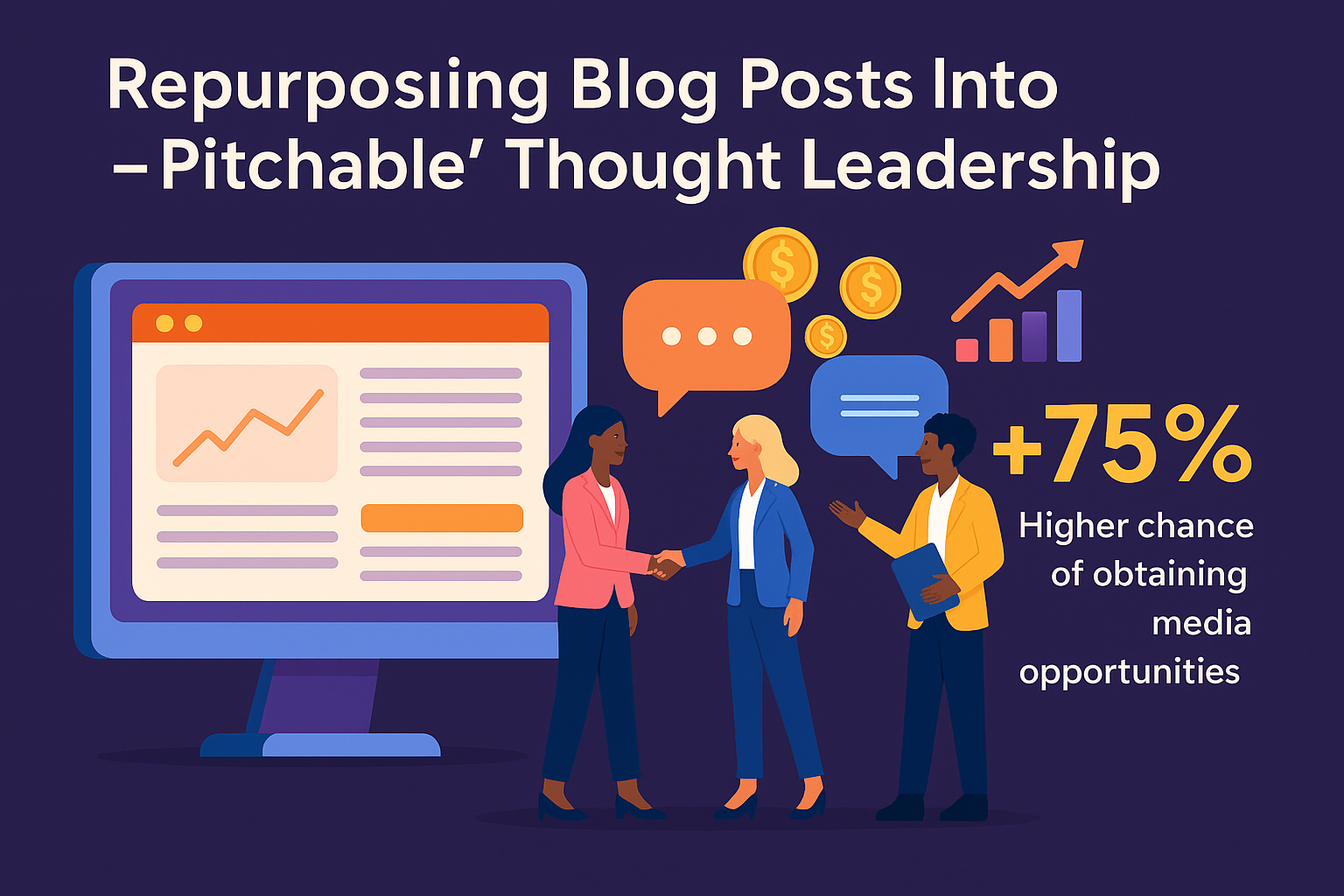
How to Craft a Compelling Founder Story for Press
A founder story is key to being memorable in the press and aligning your personal PR with your business’s long-term goals. People want to know how and why your brand cares about certain causes or why your brand holds certain values. Here’s how to craft a compelling founder story:
1. Elements of a great founder story
The following are some of the key components for a great founder story:
- Mission
What is your brand working towards? Is there a higher mission that you want to align yourself with? And how will buying your product or service help your target market serve the same mission? Every brand has a mission, where they saw that a particular niche wasn’t tapped into, or a specific problem wasn’t being taken seriously by the preexisting market. Therefore, your product or service is the solution to this problem and what the market needs most at this time.
- Conflict
Gaining upward momentum isn’t easy. No startup has an easy path, and everyone knows this too well. It’s natural to have conflicts or speed bumps along the way! You can use your business’s initial obstacles in your founder story to show how your brand was eventually able to overcome them with the combined skills of your founders. This positions your founders in a way that highlights their tenacity and passion; you need both of these to become thought leaders in your niche.
- Turning point
When did things start to take a turn for the better? There’s always a good turning point in every engaging story. Maybe your initial struggle for funding was alleviated, or you finally began to get the media exposure you needed. This is a critical part of the founder story, where your brand starts to see success from all of your hard work, finally.
- Insight
After all of your struggles and obstacles, what knowledge and insights have you gained? How is your brand planning to move forward with its newfound success? This is the moment where you can show how your business has risen to the challenge.
2. Why journalists care about your story more than your product
Journalists care about your story because they’re natural storytellers. They need a good story to bring attention to your brand through their pieces. As long as there’s a compelling story for them to use, the audience engagement will come naturally. People will be able to either relate to your journey or feel inspired by it. With a story, journalists can also highlight the people behind your brand, which humanises your business to readers.
3. Building a “hero’s journey” narrative around your startup’s creation
Why does the “hero’s journey” matter? The literary concept of the “hero’s journey” involves the main character embarking on an adventure for self-discovery, facing a crisis, and returning transformed. You can apply the narrative of the “hero’s journey” to your own founder story. As a founder, you are at the beginning of your own adventure with your startup! There are three main sections in the “hero’s journey”:
- Call to action
- What is it:
- The moment the hero is called out of their comfort zone. They’re about to embark on an important journey. They must address a problem they can’t ignore or complete a mission they feel compelled to accomplish.
- How to apply:
- What problem did you see in the world? What problem can be fixed by your product or service?
- Road of trials
- What is it:
- The hero faces numerous obstacles, challenges, and personal frustrations that test their resolve and mission.
- How to apply:
- What struggles did you have as a founder, and how did you overcome them? For example, these struggles could include building a team, overcoming self-doubt, product failure, and a lack of growth, among others.
- The transformation
- What is it:
- The hero finishes their journey and completes their transformation into a wiser, stronger person. Their sense of purpose is fulfilled, and they emerge as a leader.
- How to apply:
- After all your struggles, what have you learned about yourself and your mission? How have you overcome your struggles, and how will you inspire others?
Having a solid founder story will be the key to success for your PR strategy!
5 Types of Press Coverage That Matter Pre-Fundraising
There are lots of different types of press coverage out there, but these are the five main types that will help boost your business’s pre-fundraising PR growth:
1. Thought leadership articles (Forbes, Medium, LinkedIn)
Why does it matter: Investors want to support founders who are industry experts or innovative members of their field.
The impact on your PR: Being featured in thought leadership articles on platforms like Forbes, Medium, or LinkedIn will boost the credibility of your founders. It will also demonstrate your wide breadth of knowledge surrounding the market you’re in and prove to your network why your founders are people to look to for a fresh idea.

2. Industry newsletter features
Why does it matter: Industry newsletters are designed to share new insights and information about any given field.
The impact on your PR: Your startup can be showcased to a highly targeted group of people who are most likely to be interested in your business’s upward growth.
3. Niche podcast interviews
Why does it matter: Being on podcasts with a targeted audience can help you engage further with the people that matter. Podcasts covering specific topics or areas will also allow you to speak on issues specifically relevant to the growth of your startup.
The impact on your PR: Listeners can hear directly from your founders, which creates a sense of authenticity and honesty for your brand. Content generated from podcast interviews can also be repurposed as short clips for social media.

4. Local media, startup community coverage
Why does it matter: Early traction can always benefit from community validation, where your growth is justified by local interest in your brand.
The impact on your PR: You get to be recognised by your local community, where you can start building your audience from the ground up.
5. Awards or recognition in startup directories
Why does it matter: Having recognition in startup directories will make journalists and scouts take more of an interest in your business.
The impact on your PR: These awards validate the rising momentum and success of your growing business. They’re proof that your work is being recognised by other experts in your network, and it’s incredibly accessible to self-nominate for these.
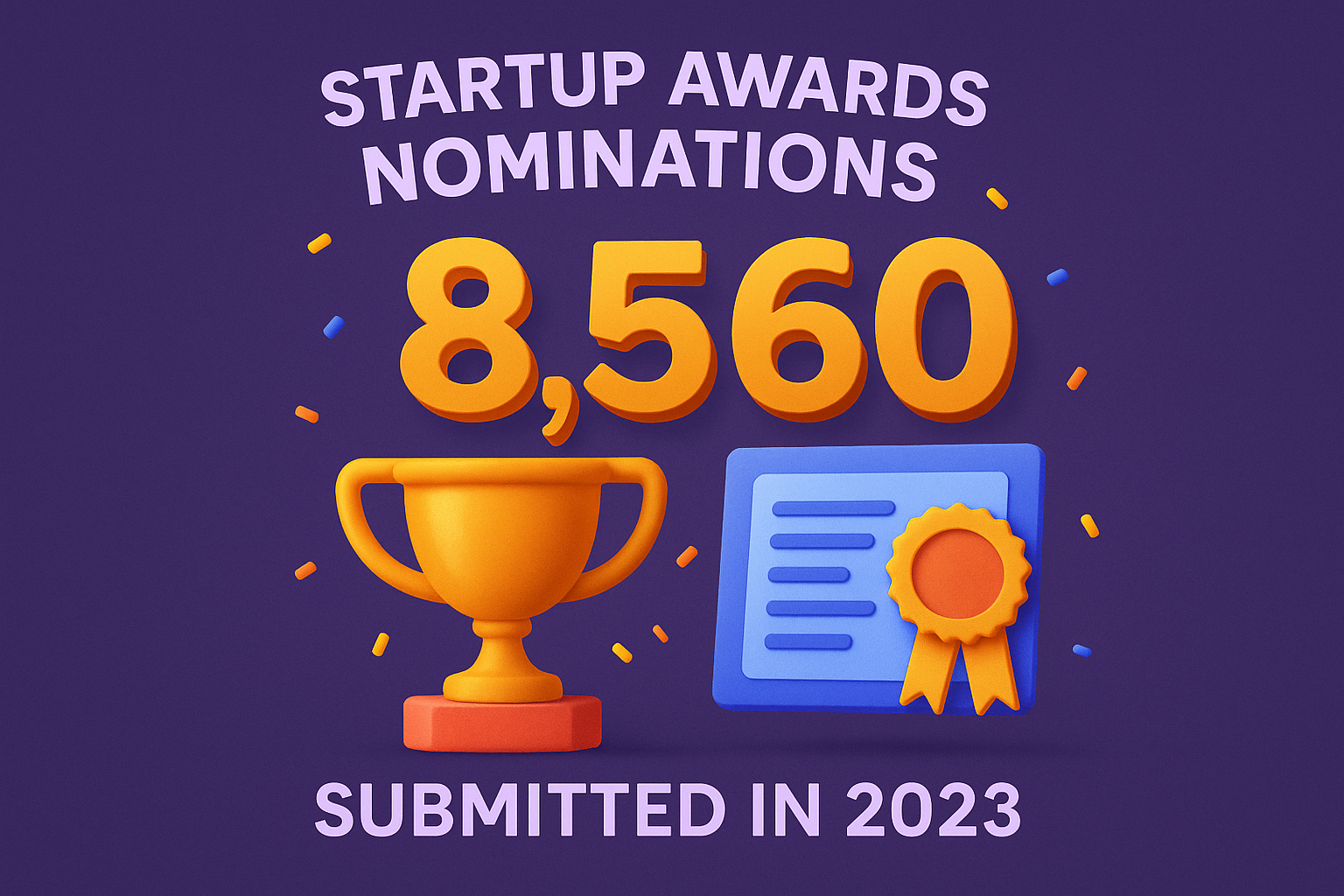
Ultimately, any kind of favorable press coverage helps! However, being able to use the content to your specific advantage is what matters.
PR Mistakes Founders Make (And How to Avoid Them)
Founders often make common mistakes when using a PR strategy for the first time. Here’s how to avoid these mistakes:
Common PR mistakes | How to avoid it |
Failing to measure results | Track the success of your online PR using any KPIs you can access. This can be social media insights, any data you can collect on traffic, mentions on different accounts, and more. |
Neglecting crisis planning | When you have a PR emergency or need to make an amendment, you need a crisis communication plan in place. This will help you respond as efficiently as possible to anything that might damage your online reputation. |
Having unclear messaging | Base your brand image around a clear yet compelling narrative that aligns with your business values. |
Waiting too long to start PR | Make sure to start PR as early as you can. Building your PR strategy is a marathon, not a sprint. Getting a good reputation in the media early on will help build lasting relationships. |
Having unrealistic goals | PR may not yield many instant conversions, but it’s essential to consider things from a long-term perspective. The primary goal of PR is to build brand awareness and credibility. You need both of these things first before a massive boost in conversion rate. |
Overall, PR can be challenging at times, but understanding the common mistakes made will help you avoid them.
Conclusion: Visibility Is a Growth Engine - Not a Luxury
Visibility isn’t something that comes overnight – it comes from hard work and a PR strategy that will be effective in the long term.
Founders sometimes assume that PR is something you can just “save for later”, but that’s untrue. PR can be a significant game-changer early in the development stage of startup building.
Frequently Asked Questions
What’s the best time to start PR as a founder?
The best time is before you start fundraising. Early PR builds credibility, increases brand visibility, and warms up investor interest. It gives you control over your narrative and helps investors find strong signals of traction when they research your brand. Starting PR early creates trust before your first pitch.
How does PR help startups raise funding?
PR helps showcase momentum, market interest, and founder credibility – all key factors that investors look for. Media coverage, customer stories, and thought leadership build trust and make your startup appear active, valuable, and investable. It helps you attract more warm introductions instead of relying solely on cold outreach.
How does PR help develop and raise awareness for your brand image?
PR enables you to control how the world perceives your brand. By sharing your mission, founder story, product vision, and customer success stories through trusted media, you shape public perception. Over time, this builds authority, trust, and top-of-mind visibility in your niche, especially important for startups entering competitive markets.
Can I do PR myself without a PR agency?
Yes, you can. Many founders successfully manage lean PR using tools like HARO, Qwoted, and social media. Start by crafting a strong founder story, pitching to niche podcasts or journalists, and repurposing blog content into thought leadership. While agencies help scale efforts, early PR is often best done by the people closest to the brand – you.
What types of media coverage do investors notice most?
Investors pay attention to media that builds credibility and shows traction. These include:
Thought leadership articles (Forbes, LinkedIn, Medium)
Niche podcast interviews
Industry newsletter features
Local startup community coverage
Awards or rankings in startup directories
Coverage in these areas tells investors you’re trusted, relevant, and gaining momentum.

